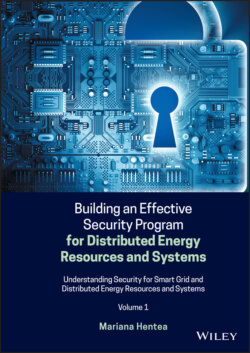Читать книгу Building an Effective Security Program for Distributed Energy Resources and Systems - Mariana Hentea - Страница 26
1.3 Distributed Energy Resources
ОглавлениеDistributed energy resources or DERs are dispatchable energy generation and storage technologies, typically up to 10 MWs in size, that are interconnected to the distribution grid to provide electric capacity and/or energy to a customer or a group of customers and potentially export the excess to the grid for economical purposes. Distributed generation (DG), distributed resources (DR), DER, or dispersed power (DP) is the use of small‐scale power generation technologies located close to the load being served. DERs may be subdivided into:
DG, which can be classified as:Renewable generation, e.g. small wind power systems, solar photovoltaic (PV), fuel cells, biofuel generators and digesters, nuclear, hydro, and other generation resources using renewable fuelNonrenewable generation, e.g. microturbines, small combustion turbines, diesel, natural gas and dual‐fueled engines, etc.
Distributed storage, which can be classified as electric storage, mechanical, electrochemical, thermal, etc.Electric storage, e.g. battery systems and uninterruptible power supplies (UPS), flywheel, superconducting magnetic energy storage (SMES), etc.Thermal storage – these convert electric power to thermal (cooling/heating) energy for later use, e.g. ice‐based air cooling system and high‐capacity brick‐based air heating system.
Plug‐in electric vehicles (PEVs) and hybrid vehicles (PEV/PHEV) may also be considered as DER; the EVs may be used to supply stored electric energy back to the grid.
DERs are small, modular, energy generation and storage technologies that provide electric capacity or energy where it is needed. A unified and generally accepted definition of DER does not exist, so many definitions have evolved from different perspectives over time.
The current trend to a utility infrastructure containing DERs (also called DG), energy storage systems, and central control may offer future relief from grid‐transmitted and facility‐caused disturbances. The financial impacts of less than adequate power quality and reliability and the consequent demand for solutions, coupled with the unique characteristics of DERs, offer an opportunity for more rapid deployments of DERs as primary and/or backup power supplies. DERs have the potential to overcome utility and site‐specific supply problems and to help compensate for other developing limitations of the existing distribution grid.
A DER is a device that produces electricity and is connected to the electrical system, either behind the meter in the customer’s premises or on the utility’s primary distribution system. A DER can utilize a variety of energy inputs including, but not limited to, liquid petroleum fuels, biofuels, natural gas, sun, wind, and geothermal energy. Electricity storage devices can also be classified as DERs.
DERs are smaller power sources that can be aggregated to provide power necessary to meet regular demand. As the electricity grid continues to modernize, DERs based on storage and advanced renewable technologies can help facilitate the transition to a smarter grid [EPRI 2015].
